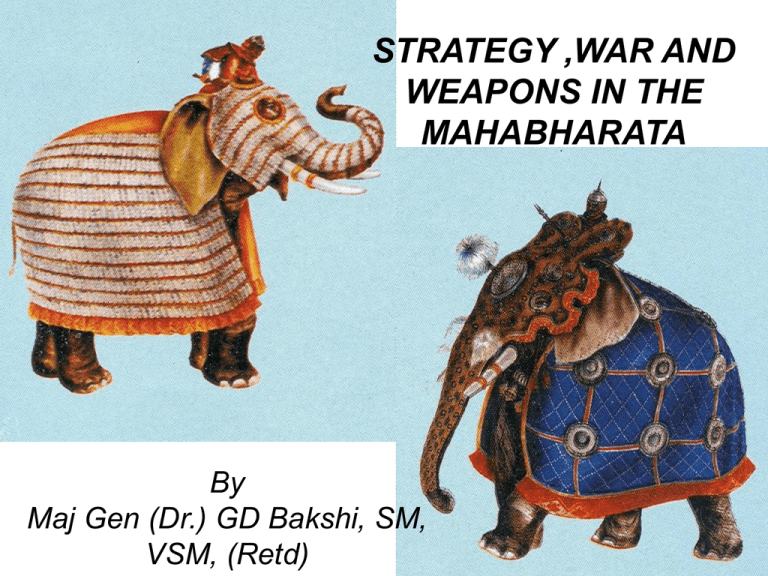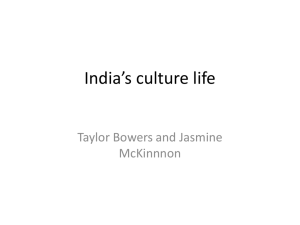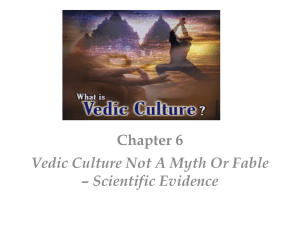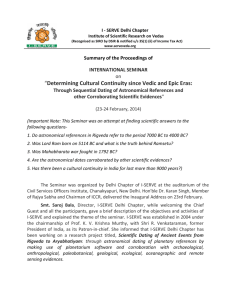By Maj Gen (Dr.) GD Bakshi, SM, VSM, (Retd
advertisement

STRATEGY ,WAR AND WEAPONS IN THE MAHABHARATA By Maj Gen (Dr.) GD Bakshi, SM, VSM, (Retd) LEARNING FROM HISTORY THE MULTI-POLAR CONTEXT • • • • • • The period of the warring kingdoms occurred in China during the Fifth Century BC, when six large kingdoms constantly struggled for supremacy. Most Chinese Military theories on War are traced back to this period- including Sun Tzu’s The Art of War. Chinese scholars feel this period of the warring kingdoms in Chinese History is very deeply analogous to the present day era of a Multi-polar world order. Hence there are valuable lessons to be learnt from the Chinese period of the warring kingdoms that are very relevant in the modern context. Senior Col Liu Chungzhi of the Strategic Dept of the NDU states that the “Multi –Polar world order of today is amazingly similar to the warring states era”. In 1996, the General Staff Dept of the PLA published six volumes of studies of ancient statecraft and war fighting strategies of that ancient period that contained advice on how to comprehend the current and future security environment based on an analysis of the ancient past. MULTI-POLARITY IN INDIAN MILITARY HISTORY • • • • • • There were two major periods of Multi-polarity in Indian history. The Mahabharata and the period preceding the Mauryan Empire. Most of Indian writings on war/statecraft can be traced to these periods of multipolarity. These resulted in the Mahabharta and the Arthashastra as the principle texts that recorded the Strategic culture of their eras. in the later Vedic age and before the Mauryan empire there were 16 major states or Maha Janapadas that were constantly at war with one another. The first period of the warring kingdoms (of Multipolarity) in India led to the mighty Armageddon of the Mahabharata., a destructive and highly debilitating civilisational conflict. The second led to the establishment of the Mauryan empire that for the first time, transformed India from a civilisational to a unified political entity and truly THE GEOPLOITICAL CONTEXT OF THE MAHABHARATA • • • • • • Let us focus today on the First Phase of Multi-polarity in India to derive lessons for the current context. A deeper analysis indicates a sophistication of strategic thought that is surprising and has great lessons for the present. Ideological context: Before the Mahabharata war, there was an upsurge of democratic ideas in India with the rise of the clan republics of the Yadavas in Mathura- led by Krishna and Balarama. Like the French Revolution, this upsurge of democratic ideas greatly perturbed the monarchies in India. All the monarchies combined to form a Confederacy of kings led by Jarasandh to destroy the emerging Yadava Republic in Mathura. Like Mao-ze-dong, Krishna broke from tradition by engaging in a massive strategic retreat from Mathura to Gujrat- to escape the incessant attacks of the monarchial powers. Once in Gujarata, he was not sidelined from the Indian geostrategic scenario. It is said he deliberately engineered a major war between the monarchial states by STRATEGIC THOUGHT: MAHABHARATA TO KAUTILYA • • • • • As a grand strategy- Krishna’s design of engineering a major clash between the monarchial powers (on the principle of succession) was a masterpiece of strategic thinking. It is only matched by the British Success during the Second World War in inducing Nazi Germany and Soviet Union to clash and destroy one another. This Armageddon however- also drained the British Empire( A result rather similar to the Mahabharata narrative). India splintered thereafter into a number of feuding states and clan republics that were constantly at war with one another. The Greek invasion of Alexander in the Third Century BC was met with disarray on the Indian side. This threat of the Greek Non-self helped to crystallize the Indian sense of Self. Kautilya forced Alexander to abort his invasion by a spectacular Psychological/ Information operation that exploited the terrific impact of the war elephants on the Greek Psyche. VEDIC – CHARIOT BASED RMA RMA BASED ANALYSIS OF INDIAN MILITARY HISTORY (EARLY VEDIC AGE) • Armies of the early Vedic age had two basic arms Infantry and Chariots. The nascent RMA of war chariots enabled chariot mounted archers to arrive fresh in the battle field • • • • • • Chariots could carry large quantities of armaments (spears, arrows, javelins) Chariots gave limited protection to combatants Mounted platform for fighting/command & control Solid wheels, later spoked wheels The mass x velocity approach – an attrition oriented paradigm. Tribal basis of military organisation (Kula, Vis, Jana) Battles of the early Vedic age • • • • • Sieges of a 100 fort-cities. Destruction of 90 forts of Dasyu ruler Shambara by King Divodasa. Indra called Purandara – destroyer of forts Battles with the Dasas, Panis and other local tribes Dasarajan. War of 10 kings won by king Sudasa on the banks of the Ravi river (1900 BC) Down River Naval expeditions? Ships with a hundred oars? Sea borne trade /commerce. Pirate attacks THE LATER VEDIC PERIOD : THE EVOLUTION OF THE FOUR ARMED MILITARY ORGANISATION OF MAHABHARATA • • • The 16 Mahajanapadas. 16 large states/kingdoms emerged in the Indo Gangetic Plains (Gandhara, Kamboja, Assaka, Vatsa, Avanti, Shursena, Chedi, Malla, Kuru, Panchala, Matsya, Vrijji, Kashi, Koshala, Maghada and Anga ) Analogues to the Period of the Warring Kingdoms in China (450 – 300 BC). Six states of Chi, Chu, Chin, Wei, Han and Chao engaged in incessant warfare. Sun Tzu and number of military theorists emerged in this period and the Art of war was formalized in China Chaturanga Bala. Organizational RMA of four limbed armies crystallised by the Mahabartan period in India (1400 BC – 900 BC?) along with attrition theories of war Chariots (Ratha) War Elephants (Gaja) Horse Cavalry (Ashwa) Infantry (Paditi) KAMBOJA GANDHARA PANCHALA KURU KOSALA KASHI MAGADHA MAHABHARATAN PARADIGM • Vyuhas Formations and battle drills to coordinate action of the four variable speed maneuver masses on a given battle field. (Evolved from the game of Chausar or Indian Chess)” Kill drills or combined arms battle drills • Attrition Oriented Approach. Force on force engagements to wear the opponent down by sheer attrition. Enemy expected to be met in a designated battle plain where Vyuha drills could be applied for systematic slaughter • Chivalry. No fighting by night, no attacks on fleeing soldiers etc. Gladiatorial contests – Chariots fought Chariots Makara Vyuha Shakta Vyuha Sarbatomukha Vyuha German Laager Adopts Defensive Formation as Screen Contacts British Armour German Laager Adopts Defensive Formation as Screen Contacts British Armour











